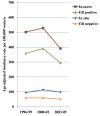Recent breast cancer incidence trends according to hormone therapy use: the California Teachers Study cohort
- PMID: 20064209
- PMCID: PMC2880422
- DOI: 10.1186/bcr2467
Recent breast cancer incidence trends according to hormone therapy use: the California Teachers Study cohort
Abstract
Introduction: Recent, international declines in breast cancer incidence are unprecedented, and the causes remain controversial. Few data sources can address breast cancer incidence trends according to pertinent characteristics like hormone therapy use history.
Methods: We used the prospective California Teachers Study to evaluate changes in self-reported use of menopausal hormone therapy (HT) between 1995 to 1996 and 2005 to 2006 and age-adjusted breast cancer incidence among 74,647 participants aged 50 years or older. Breast cancer occurrence was determined by linkage with the California Cancer Registry.
Results: During 517,286 woman years of follow up, 565 in situ and 2,668 invasive breast cancers were diagnosed. In situ breast cancer incidence rates in this population did not change significantly from 2000 to 2002 to 2003 to 2005, whereas rates of invasive breast cancer declined significantly by 26.0% from 528.0 (95% confidence intervals (CI) = 491.1, 564.9) per 100,000 women in 2000 to 2002 to 390.6 (95% CI = 355.6, 425.7) in 2003 to 2005. The decline in invasive breast cancer incidence rates was restricted to estrogen receptor-positive tumors. In 1996 to 1999 and 2000 to 2002 invasive breast cancer incidence was higher for women who reported current HT use especially estrogen-progestin (EP) use at baseline than for never or past users; but by 2003 to 2005 rates were comparable between these groups. For women who were taking EP in 2001 to 2002,75% of whom had stopped use by 2005 to 2006, incidence had declined 30.6% by 2003 to 2005 (P = 0.001); whereas incidence did not change significantly for those who never took HT (P = 0.33).
Conclusions: Few data resources can examine prospectively individual HT use and breast cancer diagnosis. Stable in situ breast cancer rates imply consistent levels of screening and suggest recent declines in invasive breast cancer to be explained predominantly by changes in HT use.
Figures



Comment in
-
Recent declines in breast cancer incidence: mounting evidence that reduced use of menopausal hormones is largely responsible.Breast Cancer Res. 2010;12(1):103. doi: 10.1186/bcr2463. Epub 2010 Feb 12. Breast Cancer Res. 2010. PMID: 20236464 Free PMC article.
Similar articles
-
Recent trends in hormone therapy utilization and breast cancer incidence rates in the high incidence population of Marin County, California.BMC Public Health. 2010 Apr 30;10:228. doi: 10.1186/1471-2458-10-228. BMC Public Health. 2010. PMID: 20433756 Free PMC article.
-
Alcohol consumption and breast cancer risk among postmenopausal women following the cessation of hormone therapy use: the California Teachers Study.Cancer Epidemiol Biomarkers Prev. 2012 Nov;21(11):2006-13. doi: 10.1158/1055-9965.EPI-12-0418. Epub 2012 Jul 25. Cancer Epidemiol Biomarkers Prev. 2012. PMID: 22832206 Free PMC article.
-
Screening mammography use among current, former, and never hormone therapy users may not explain recent declines in breast cancer incidence.Cancer Epidemiol Biomarkers Prev. 2012 May;21(5):720-7. doi: 10.1158/1055-9965.EPI-11-1115. Epub 2012 Feb 1. Cancer Epidemiol Biomarkers Prev. 2012. PMID: 22301831 Free PMC article.
-
Changing concepts: Menopausal hormone therapy and breast cancer.J Natl Cancer Inst. 2012 Apr 4;104(7):517-27. doi: 10.1093/jnci/djs014. Epub 2012 Mar 16. J Natl Cancer Inst. 2012. PMID: 22427684 Free PMC article. Review.
-
Declines in breast cancer after the WHI: apparent impact of hormone therapy.Cancer Causes Control. 2007 Oct;18(8):847-52. doi: 10.1007/s10552-007-9029-1. Epub 2007 Jul 6. Cancer Causes Control. 2007. PMID: 17619153 Review.
Cited by
-
Dietary patterns and breast cancer risk in the California Teachers Study cohort.Am J Clin Nutr. 2013 Dec;98(6):1524-32. doi: 10.3945/ajcn.113.061184. Epub 2013 Oct 9. Am J Clin Nutr. 2013. PMID: 24108781 Free PMC article.
-
Recent declines in breast cancer incidence: mounting evidence that reduced use of menopausal hormones is largely responsible.Breast Cancer Res. 2010;12(1):103. doi: 10.1186/bcr2463. Epub 2010 Feb 12. Breast Cancer Res. 2010. PMID: 20236464 Free PMC article.
-
Impact of adjuvant chemotherapy on T1N0M0 breast cancer patients: a propensity score matching study based on SEER database and external cohort.BMC Cancer. 2022 Aug 8;22(1):863. doi: 10.1186/s12885-022-09952-z. BMC Cancer. 2022. PMID: 35941565 Free PMC article.
-
Anthropometric, behavioral, and female reproductive factors and risk of multiple myeloma: a pooled analysis.Cancer Causes Control. 2013 Jul;24(7):1279-89. doi: 10.1007/s10552-013-0206-0. Epub 2013 Apr 9. Cancer Causes Control. 2013. PMID: 23568533 Free PMC article.
-
Dietary patterns and endometrial cancer risk in the California Teachers Study cohort.Cancer Causes Control. 2015 Apr;26(4):627-34. doi: 10.1007/s10552-015-0552-1. Epub 2015 Mar 12. Cancer Causes Control. 2015. PMID: 25761409 Free PMC article.
References
Publication types
MeSH terms
Substances
Grants and funding
LinkOut - more resources
Full Text Sources
Medical
Miscellaneous

